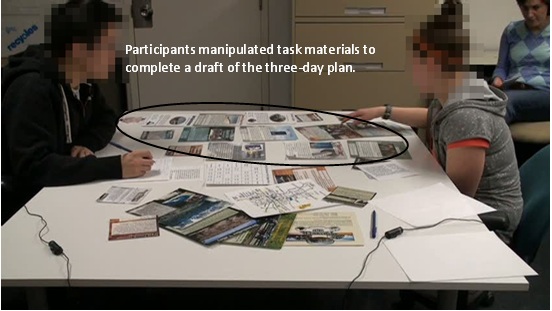Impact of Table Size on External Cognition during Collaborative Problem-Solving
Description
Tables have been used to support individual and group activities for centuries. Collaborative tabletop activities such as planning, designing, and scheduling are common on traditional tables, yet digital tables still face a variety of design issues to facilitate these same tasks. For example, due to the high cost of digital tables, it is unclear how large a digital table must be to support collaborative problem solving.
This project examines the impact of physical features, in particular the table size, on collaborative tasks. This research leverages findings of previous studies of traditional and digital tables, and focuses on exploring the interaction of table size and users’ seating arrangement in collaborative problem solving. An experimental study is used to observe the behaviour of two-member groups performing problem-solving tasks on traditional tables. Two tasks, storytelling and travel planning, are included in this study. The experiment includes two sizes of tables, one small and one large. Although working on digital and traditional tables differs, investigating the impact of physical features in traditional tables can help us better understand how these features interact with workspace awareness and external cognition factors during taskwork.
In the empirical study, external cognitive behaviors of participants are deeply analyzed to understand how physical settings of the table and seating arrangement affect the way people manipulate artifacts in the table workspace. Study findings reveal that collaborators pass through different stages of problem solving using varied strategies. Moreover, the data analysis reveal that people use a number of different object manipulate strategies to help understand, organize and create a solution during the different problem solving tasks. These manipulation strategies include the use of various external cognition behaviours, including visual separation, cognitive tracing (i.e. ordering and reordering materials to try out different potential solution forms), and piling. Table size, task type and user seating arrangement factors all show strong effects on such external cognition behaviours. In particular, the accessibility of sufficient space on the table influences how much users distribute their materials to improve workspace awareness and cognitive tracing.
This research can be used to inform design decisions regarding size and seating arrangement for tabletop workspaces, on both traditional and digital tables. Moreover, insights gained from this research can help provide solutions for situations when a digital tabletop workspace does not provide sufficient space for a given task or usage context. See the publications listed below for more details.
Project Images
| Table Size and Seating Arrangement Conditions used in the study | Example of one participant group performing cognitive tracing external cognition behaviour while performing the travel planning task. |
|---|---|
 |
 |



